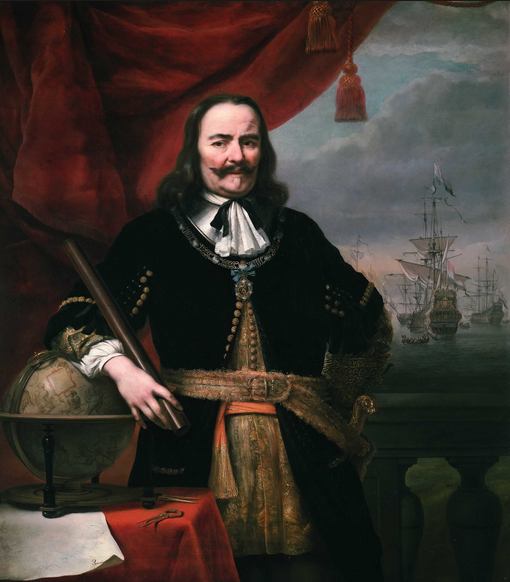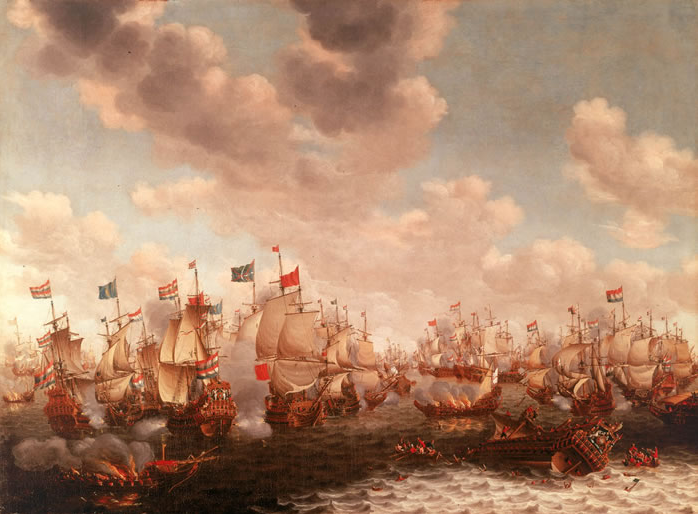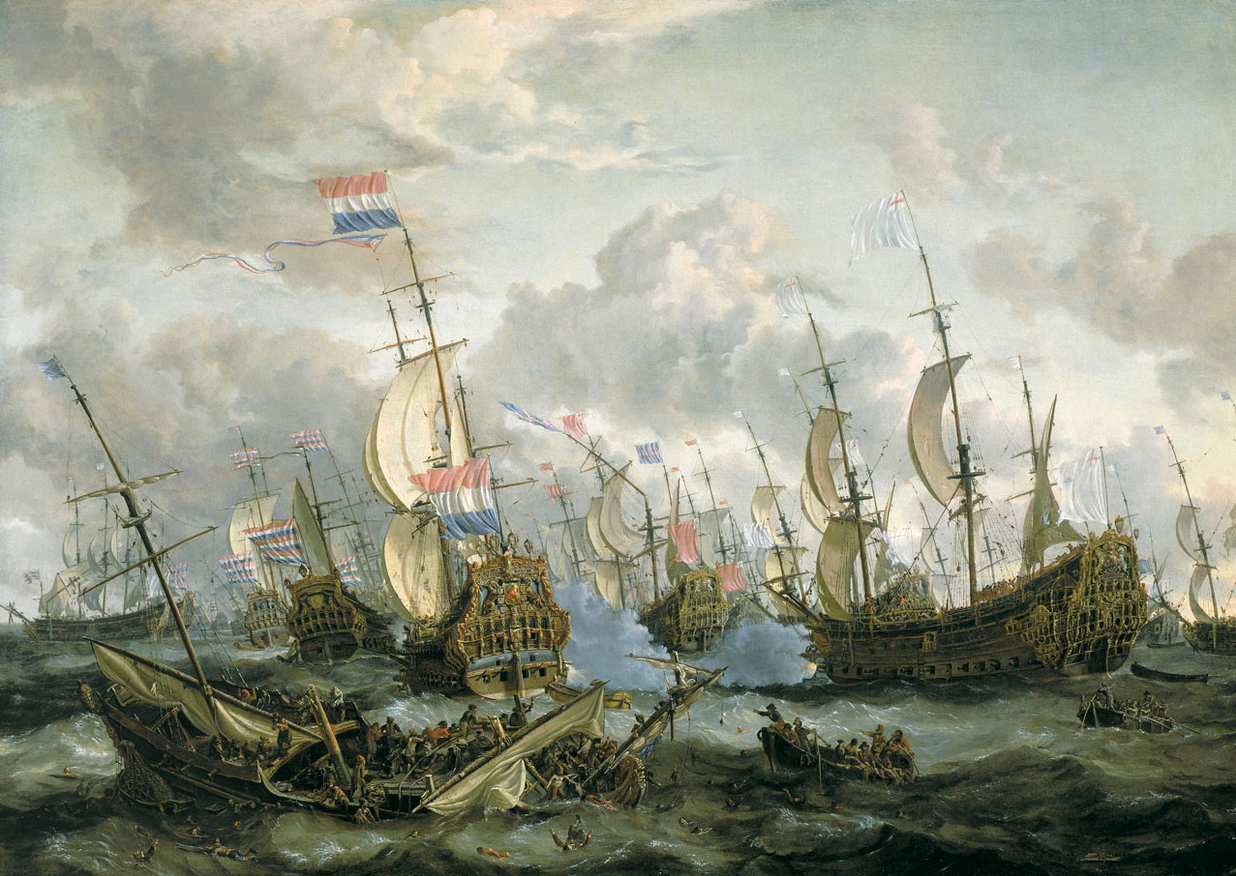Editor’s note: The following is extracted from A History of Sea Power, by William Oliver Stevens and Allan Westcott (published 1920). All spelling in the original.
The Second Dutch War
Five years after Charles II became king, England was involved in another war with the Netherlands. There was still bad feeling between the two peoples, and trading companies in the far east or west kept up a guerilla warfare which flooded both governments with complaints. The chief cause seems to have been the desire of the English Guinea Company to get rid of their Dutch competitors who persistently undersold them in the slave markets of the West Indies. Before there was any declaration of war an English squadron was sent out to attack the Dutch company’s settlement on the West African coast. After this it crossed the Atlantic and took New Amsterdam, which thereafter became New York. The Dutch retaliated by sending out one of their squadrons to retake their African post and threaten the Atlantic colonies. In March, 1665, war was declared.
In this conflict the relative strengths of the two navies were about the same as in the previous war. The Dutch had made improvements in their ships, but they still suffered from the lack of unity in organization and spirit. The first engagement was the battle of Lowestoft, on June 3, 1665. The English fleet was under the personal command of the Duke of York, later James II; the Dutch were led by de Ruyter. The two forces numbered from 80 to 100 ships each, and strung out as they were, must have extended over nearly ten miles of sea. The Duke of York formed his fleet in the pattern that he set by his own “Fighting Instructions,” which governed the tactics of all navies thereafter for a hundred years, namely, the entire force drawn up in single line. This line bore down abreast toward the enemy until it reached gunshot, then swung into line ahead and sailed on a course parallel to that of the enemy. De Ruyter arranged his fleet accordingly, and the two long lines passed each other on opposite tacks three times, cannonading furiously at close range. This meant that the force was distributed evenly along the enemy’s line and as against an evenly matched force these tactics could result, as a rule, only in mere inconclusive artillery duels which each side would claim as victories. In the battle of Lowestoft, however, several of the captains in the Dutch center flinched at the third passing and bore up to leeward, leaving a wide gap in de Ruyter’s line. The English broke through at this point and hammered the weakened Dutch line in the center with a superior force. This was the decisive point in the battle and de Ruyter was forced to retreat. The Dutch would have suffered even greater loss than they did had it not been for the masterly fashion in which Cornelius Tromp—son of the famous Martin Tromp—covered the retreat.

The defeat of the Dutch was due to the bad conduct of the captains in the center, four of whom were shot by order of de Ruyter and others dismissed from the service. It is interesting to note that while the first half of the battle was fought on the formal lines that were soon to be the cast iron rule of conduct for the British navy, and led to nothing conclusive; the second half was characterized by the breaking of the enemy’s line, in the older style of Blake, and led to a pronounced victory.
At this time Louis XIV had pledged himself to give aid to the Netherlands in case of attack by a third Power. But when the Dutch and his own ministers called on him to make good his promise he offered more promises and no fulfillment. The rumor of an approaching French squadron which was to make junction with de Ruyter, who had now been placed in command of the Dutch fleet, caused the English government to make the grave mistake of detaching Prince Rupert with 20 ships to look for the mythical French force. This division left Monk, who was again in command of the fleet, with only 57 ships. Hearing that de Ruyter was anchored on the Flanders coast, Monk went out to find him. De Ruyter left his anchorage to meet the English, and on June 1, 1666, the two forces met in mid-Channel, between Dunkirk and the Downs. As the Dutch force heavily outnumbered him—nearly two to one—Monk might have been expected to avoid fighting, but he acted in the spirit of Blake. Having the windward position he decided that he could strike the advanced division under Tromp and maul it severely before the rest of the Dutch could succor it. Accordingly he boldly headed for the enemy’s van. When Monk attacked he had only about 35 ships in hand, for the rest were straggling behind too far to help. Thus began the famous “Four Days’ Battle,” characterized by Mahan as “the most remarkable, in some of its aspects that has ever been fought upon the ocean.”

The fighting was close and furious and in its unparalleled duration numbers were bound to tell. On the third day Monk retreated to the Thames, but on being joined by Rupert’s squadron immediately sallied forth to do battle again. On this day, June 4, the Dutch succeeded in cutting through his formation and putting him between two fires. Indeed Monk escaped destruction only by breaking through his ring of enemies and finding refuge in the Thames. The Dutch had won a great victory, for the English had lost some twenty ships and 5000 in killed and wounded. But Monk was right in feeling a sense of pride in the fight that he had made against great odds. The losses that he had inflicted were out of all proportion to the relative strength of the two forces. Unfortunately the new spirit that was coming into the navy of the Restoration was evidenced by the fact that a number of English captains, finding the action too hot for them, deserted their commander in chief. On the Dutch side de Ruyter’s handling of his fleet was complicated by the conduct of Cornelius Tromp. This officer believed that he, not de Ruyter, should have been made commander of the Dutch fleet and in this action as in the next, acted with no regard for his chief’s orders.
As a consequence of the Four Days’ Battle, Dutchmen again controlled the Channel and closed the mouth of the Thames to trade. The English strained every nerve to create a fleet that should put an end to this humiliating and disastrous situation. The preparations were carried out with such speed that on July 22 (1666), Monk and Rupert anchored off the end of the Gunfleet shoal with a fleet of about 80 ships of the line and frigates. On the 25th the English sighted de Ruyter, with a fleet slightly larger in numbers, in the broad part of the Thames estuary. Monk, forming his fleet in the long line ahead, sailed to the attack. The action that followed is called the “Battle of St. James’s Day” or the “Gunfleet.”









